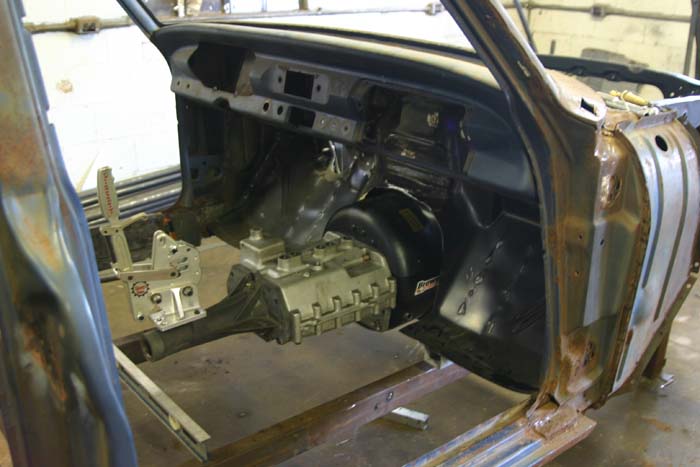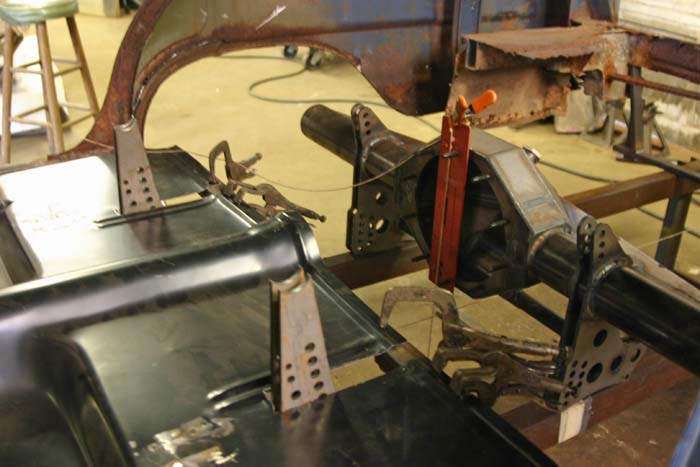PROJECT WHITE WAGON: WE ARE ROLLING AGAIN
 Demands of remaining on the cutting edge of technology, along with the procurement of crucial elements for Project White Wagon, slowed our progress on the junkyard to SS/E Modified project car. We’re pleased to report that progress has resumed at a rapid rate with frequent updates.
Demands of remaining on the cutting edge of technology, along with the procurement of crucial elements for Project White Wagon, slowed our progress on the junkyard to SS/E Modified project car. We’re pleased to report that progress has resumed at a rapid rate with frequent updates.
When we last left our Project White Wagon, we were largely in a hunting and gathering phase.
Chassis builder Tom Lukans, coordinator on our build, confirmed we are at the first required piece per the SFI 25.5 spec safety data sheets.
In getting to this point, the new floor pan from JW Nova Parts has been trimmed, modified and fitted, which is critical to the driveshaft location per NHRA rules. This will determine the actual engine location and ride height for the Project White Wagon.
Lukans has installed the rear cross-member, a 1 5/8 inch [.083] piece of chrome moly tubing, the attaching point for the QuarterMax Race Cars chassis brackets. From there we have built the lower frame rails which run to the front of the car. We have installed the firewall [from JW Nova], which has been modified to accommodate the Browell aluminum bellhousing equipped with a titanium sleeve. Our Browell Bellhousing is certified to meet and exceed S.F.I. 6.1, 6.2 or 6.3 specifications for maximum clutch/flywheel containment.

Demands of remaining on the cutting edge of technology, along with the procurement of crucial elements for Project White Wagon, slowed our progress on the junkyard to SS/E Modified project car. We’re pleased to report that progress has resumed at a rapid rate with frequent updates.

When we last left our Project White Wagon, we were largely in a hunting and gathering phase.
Chassis builder Tom Lukans, coordinator on our build, confirmed we are at the first required piece per the SFI 25.5 spec safety data sheets.
In getting to this point, the new floor pan from JW Nova Parts has been trimmed, modified and fitted, which is critical to the driveshaft location per NHRA rules. This will determine the actual engine location and ride height for the Project White Wagon.
Lukans has installed the rear cross-member, a 1 5/8 inch [.083] piece of chrome moly tubing, the attaching point for the QuarterMax Race Cars chassis brackets. From there we have built the lower frame rails which run to the front of the car. We have installed the firewall [from JW Nova], which has been modified to accommodate the Browell aluminum bellhousing equipped with a titanium sleeve. Our Browell Bellhousing is certified to meet and exceed S.F.I. 6.1, 6.2 or 6.3 specifications for maximum clutch/flywheel containment.
We have mounted the Browell unit and mocked in our Liberty Equalizer 5-speed transmission for now and by the next installment will have cut the firewall to raise the engine height. As we do this, we have planned to incorporate the drive-shaft safety loop. This is intended to provide both the maximum of safety and easy access for between rounds maintenance. The driveshaft safety loop will be attached to the X-brace so we can slide the transmission back and forth as the Pro Modified and Pro Stock cars do without having to remove the unit completely.
Long before Barbara Nesbit’s problems [click here for story link], we had already planned to include the driveshaft safety loop for added safety. The added weight, we felt, would be worth its weight in gold when it came to making the car safer. Unfortunately, Nesbitt’s incident proved us correct.
We have spared no expense to building a safer car, even going as far as to weld a plate to each end of the cross-member bar before attaching to the original steel hull.
Even as insignificant as adding these plates might be, we have to take in account each little plate and widget we add to the apple cart; as each has to be accounted for in the whole process.
“The reason we go through many of these extra steps because every time you add an extra bar for something out of the ordinary, when you add weight to a car like this, even though it has a 292-inch engine, that’s really a sewing engine by today’s standards,” Lukans said. “In the grand scheme of things, we have to be careful and be specific about every bit we add into this car.”
Much of our build is outlined in the SEMA safety manual, which guides you through the build of the car as if you are building a model car at your kitchen table.
“This is something we want our readers to understand if they are going to buy a car,” Lukans explained. “We just don’t weld a round tube to the side of the rocker panel. You have to plate it, weld it and then weld the chrome moly to the plate which is what we did here. It gives more structure and support around the whole piece.”
On the other side of the bellhousing, we will add the No. 11 bar per the SFI spec manual as a brace below the windshield into a car which requires a vastly different approach than one of today’s modern plastic and fiberglass creations from Detroit. Our car was originally built eight U.S. Presidencies ago when steel was the only accepted version.
We will weld this bar into the mid-motor plate/block protector in order to give the back part of the engine block and the center section of the car more support.
“We are just trying to get the most out of every part, or bar, we install,” added Lukans.
While procuring parts, many nearly impossible to locate, it was a tip from fellow Super Stock/Modified racer, and 1978 IHRA Pro-Am Nationals Modified eliminator winner, Wayne Allison, which led us to the exact location of a proverbial needle in a haystack.
Our fictional “needle” in this instance was a nearly mint-condition inner fender from a 1965 Nova sitting in the back of a 1970s style van in a Pacolet, SC., junk yard.
Allison had originally purchased the unit for use in a 1966 Chevy II restoration, only to find out it wouldn’t work in his application. After hearing about our threats, plights and comedic follies to build this car going on three years, he believed it was his civic duty to throw us a bone.
What a bone it was.
“We were extremely lucky to find this piece – in this good of a shape,” said Lukans, who added the inner fender had been stored in a van parked in a salvage lot. “Never been hit or been a ditch. Just had to clean it up a little but it was in good, good shape.”
And this rear-end housing sitting on the work bench from RJ Race Cars, it’s a beauty too. We’ll tell you about it in the next installment.
We promise to post it before next year too.

PAST INSTALLMENTS
* Part 1, Outlining The Project
* Part 2, Getting The Car on The Jig
* Part 3, Preparing for the Four-Link
* Part 4, Preparing the Cylinder Heads
* Part 5, Project Gains A Purpose
* Part 6, Shocking the Wagon
* Part 7, A Real Clutch Player
* Part 8, Nova Body Parts Done Right
* Part 9, Space Age Intake Meets The Basket Case
* Part 10, Dart Aftermarket Blocks Poised to Fly in Stk/SS
* Part 11, We Are Rolling Again
 PROJECT WHITE WAGON SUPPORTERS
PROJECT WHITE WAGON SUPPORTERS
TL Race Cars (864) 427-5269
Fluid Power Specialties (864) 599-1118
Minton's Wrecker Service (864) 474-2581
Fulton Competition
PART SUPPLIERS
A.E.D. Motorsports Products (tubing)
Applied Racing Technologies (A.R.T)
Aeromotive Inc. (fuel system)
Autometer Guages (tech, engine gauges)
Bill Miller Engineering (rods, pistons)
Browell Bellhousings (bellhousing)
CFE Heads (cylinder heads, intake)
CFM Composites (seats)
Carson's Nut-Bolt and Tool
Comp Cams (camshaft)
Dart Engineering (Engine Block)
Flatout Gaskets (engine gaskets)
Hedman Headers (headers)
I.R.C. (wheelie bar wheels, bracketry)
Jegs Mail Order (misc.)
J&W Nova Parts (body panels and body sheetmetal)
Liberty's Transmissions (Transmission, Gears)
Matco Tools - (tools, tool box)
Mickey Thompson Tires & Wheels (front tires, slicks)
Moroso Performance (valve covers)
QA-1 (Rod Ends)
Quartermax Racing & Chassis Components (suspension, chassis components, axles)
Ram Clutches
Santhuff Shocks (front, rear shocks)
Simpson Safety - (Helmet, Firesuit)
Strange Engineering (Axles, Rearend companents)
Weld Racing (front, rear wheels)
Winberg Crankshafts (crankshaft)



































